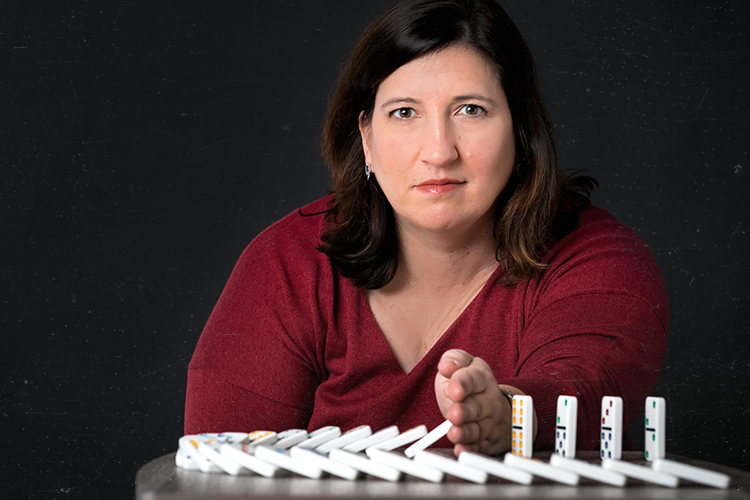
Seeing the warning signs
To improve treatment for PTSD, researchers are seeking better ways to identify its risk factors
As a child, Christine Larson was aware that her father was a Vietnam War veteran, but that was pretty much all she knew about that part of his past. She’d never heard him discuss what he’d seen and experienced in that war. His service was always in the background. If the subject came up, he would simply shut down and detach, as if holding in the hurt.
It wasn’t until years later, after Larson’s father sought mental health treatment, that he was willing to open up. “I know how people can be affected by post-traumatic stress disorder,” says Larson, a professor of psychology in the College of Letters & Science. “And I know how people live in pain, often silently.”
Larson now dedicates her work to alleviating PTSD. But while most work in the field deals with people who, like her father, have long suffered from the disorder, her current research examines the root of the problem and tries identifying risk factors for long-term post-traumatic stress. Predicting who is most vulnerable to prolonged PTSD would allow for much earlier intervention.
“With PTSD, we know the trigger, the traumatic event,” Larson says. “Because we know the starting point, it offers a window into who’s at risk and what we might do to prevent or reduce the impact.”
Larson’s early academic studies focused on the neuroscience of emotion, exploring differences in how people experience, regulate and react to emotion, as well as the brain’s role in all of that. But she was always drawn to how humans respond to trauma.
Unfortunately, the key to pinpointing PTSD’s risk factors and early warning signs is examining people right after they’ve experienced the traumatic event. Such research is a sensitive and challenging matter for several reasons, and finding enough people to support a significant study is difficult. Plenty of patients, like Larson’s father, live with trauma for years before realizing and addressing their problems. Where could an academic find a group of people recently exposed to distressing experiences?
About 10 years ago, fate intervened. Larson was a new UWM professor attending a meeting of the Clinical & Translational Science Institute of Southeast Wisconsin, an academic-community partnership between universities and hospitals in the region. She found herself sitting at a table beside another new professor, Dr. Terri deRoon-Cassini from the Medical College of Wisconsin.
As the two talked, Larson discovered that deRoon-Cassini worked as a psychologist in the trauma department at Froedtert Hospital, where victims are sent almost immediately after a violent incident. The pair quickly realized their overlapping interests, and eventually, the Milwaukee Trauma Outcomes Project was born.

Larson and deRoon-Cassini’s initial studies focused on people no more than two weeks removed from their traumatic event. Within that span, each person was asked to volunteer to come in for two consecutive days for MRI scans.
Larson and her team looked at the brain’s structure and function while people carried out simple tasks and reacted to emotional stimuli.
In addition, researchers drew blood to examine immune function and potential genetic influences. There were interviews and questionnaires gauging things like mood, substance use, work function and sleep habits. Finally, people were asked to come back five more times over the following two years to monitor any changes.
Larson based her research on well-established functions of certain regions of the brain, particularly the amygdala, which spurs fear response and vigilance, and the prefrontal cortex, which helps regulate the amygdala. She’s learned that people who show more exaggerated amygdala activation and less prefrontal cortex regulation right after a traumatic incident are likelier to have more pronounced PTSD six months later.
“It’s showing that people who can’t engage effective emotion regulation are the people we want to provide with more early intervention,” Larson says.
One key variable in this research is the type of traumatic incident and its magnitude. People visit a trauma ward for every manner of violent events. The people involved in the research of deRoon-Cassini and Larson had mostly suffered from car accidents, but some were assaulted or suffered other forms of violence.
The research showed that the objective notion of an incident’s severity was less important than a person’s own perception of how traumatic their experience was. In other words, if the person thought it was bad, so did their bodies, and that’s all that mattered.
“That’s not to say some situations aren’t objectively worse,” Larson cautions. “But it shows that if you can work with the person to reframe how they’re perceiving an event and how it’s affecting them, then you might be able to minimize their symptoms.”
Larson’s work continues with the help of a National Institutes of Health grant. Her team is expanding its research into other factors that might affect PTSD, including community violence, food security, housing insecurity and perceived discrimination.
“Brains have feet. They aren’t in a bubble,” Larson says. “We want to look at how the person’s environment impacts brain function and how that influences their risk.”